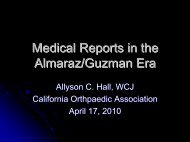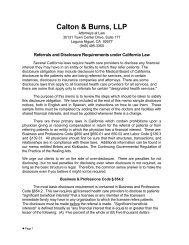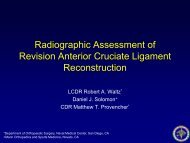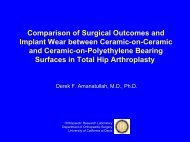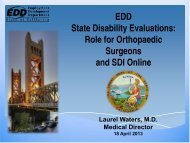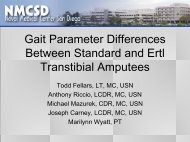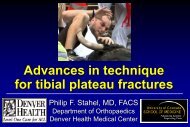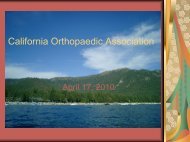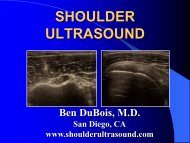Enhancing Your Practice's Revenue - California Orthopaedic ...
Enhancing Your Practice's Revenue - California Orthopaedic ...
Enhancing Your Practice's Revenue - California Orthopaedic ...
- No tags were found...
Create successful ePaper yourself
Turn your PDF publications into a flip-book with our unique Google optimized e-Paper software.
Difficult cases can lead to diagnostic errors by anyone;errors in judgment by PEs can be minimized by clarifyingtheir scope of practice. Clear protocols should be writtenand should define (a) what conditions need to be evaluatedby a physician, (b) how often a patient can be seen by thePE without a physician visit, and (c) guidelines for managementof various conditions. An open line of communicationmust be maintained between the PE and the physician. Ifan error by the PE is noted, the physician must take steps toinform the patient and manage the condition appropriately.Scribes/Medical AssistantsFinally, an alternative view of the role of scribes andmedical assistants. These persons used to be considered aluxury or at best simply an expense in most medical offices.Now, with the advent of electronic medical records (EMR),they are increasingly being seen by orthopaedic surgeons asvital to improving patient flow and efficiency. For example,if a scribe earning $15/hour enables the doctor to see twoor three additional patients generating $200-$300 perpatient, this more than pays for itself.Contact: George Russell, MD: gvrussell@umc.eduChapter 2Non-Surgical PhysiciansBy James Keeney, MDBackgroundTo an increasing extent, medical practices have started torely on passive sources of income to maintain net incomeand viability. See for example Chapter 11: Real Estate.While revenues obtained from these sources may besignificant, regional and individual practice considerationsmay limit physicians’ opportunities to participate fully inthe activities. In the future, federal and state regulatoryefforts could restrict access to some passive income sourcesand may, in fact, reward the development of completely newmodels for healthcare delivery. While passive revenues areimportant, practices must therefore still rely on providingdirect patient care to maintain a healthy bottom line.The question is how to do this in the most efficient mannergiven that:• Surgical procedures generally contribute moresubstantively to gross revenue than non-operative care.• The best use of a surgeon’s time (economically speakingat least) is therefore in the operating room.• The average orthopaedist spends between 25% and40% of his/her time in the OR but many spend more,particularly if he or she performs procedures in multiplelocations.• Not every patient seen in the office needs surgery; manycan (and should) be treated non-operatively.• Patients who do require surgery generally need to be seenseveral times in the office before and after the surgerytakes place.• The number of patients an average orthopaedist seesin the office per surgery performed varies significantlydepending on subspecialty, practice setting, andutilization of clinical support staff.• Overhead has been increasing steadily over the past fiveyears; it is currently in the range of $550,000 (between45% and 55% of gross receipts per Medical GroupManagement Association (MGMA) and AmericanAssociation of <strong>Orthopaedic</strong> Executives (AAOE).• There are numerous reasons – in addition to surgery –why a physician may not be in the office; e.g., rounds,CME, administration and vacation.• Most office expenses, including staff salaries, occupancy,insurance, utilities, and marketing, are incurred whetherthere is a doctor physically present in the office or not.Orthopaedists are placed in a “Catch-22” situation. Dothey spend time in the office, utilizing it efficiently andgenerating surgical business, or do they actually performsurgeries? Complicating matters further is the fact that agreat deal of practices’ ancillary income, including revenuesreceived from injections, x-ray, sales of supplies, and officeprocedures, is only generated when doctors are physicallypresent, and ancillary income can have a profit margin of50% to 70%. Hence, it is doubly important for an orthopaedicoffice to have professional (that is, physician) staffon site at all times.A solution to this problem is for the office to recruit andemploy additional doctors; that is, physicians who do notperform orthopaedic surgery. The key to success here isto develop a business plan for each practitioner the officewants to bring on board. The plan should consider thedirect revenues the physician will generate (plus the indirectrevenues the person will allow others to generate) and comparethese against (a) the revenues that will no longer begenerated by existing personnel and (b) the added costs theoffice will incur, including salary and benefits, professionalliability insurance, etc.UpsidesStaffing the office with physicians who do not performorthopaedic surgery has numerous advantages.• Patients can frequently be seen at very short notice. Formany people, this is very appealing and enhances theoffice’s reputation for quality and service.• Non-operative physicians will often refer patients theysee to orthopaedists for subsequent surgery.© 2011 American Academy of <strong>Orthopaedic</strong> Surgeons11




